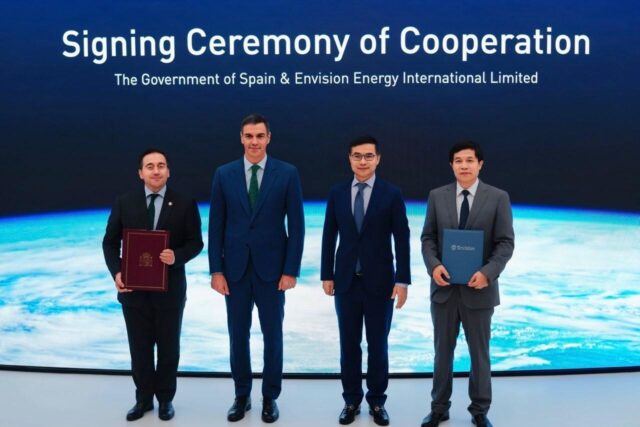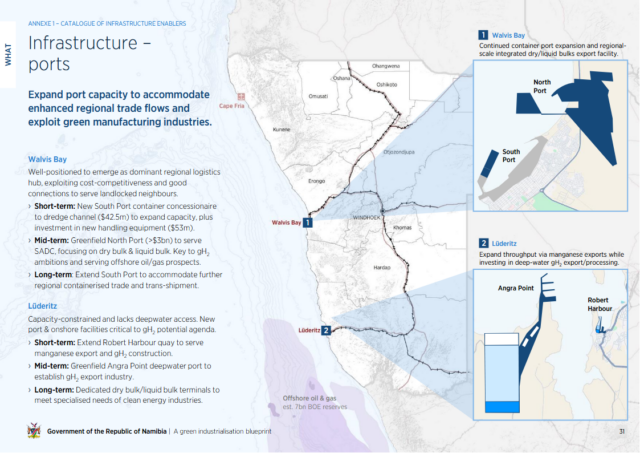Envision: renewable production in Spain and Namibia
By Julian Atchison on September 17, 2024
Billion dollar green industrial park

Click to learn. Envision executives and Spanish Prime Minister Pedro Sanchez (second from left) sign the agreement. Source: Envision Energy.
As part of a new agreement with the Spanish government, Envision will develop a fully integrated industrial park in Spain. The site will house the design, research, manufacture and maintenance capabilities for core renewable technologies including electrolysis, air separation units, and modular ammonia synthesis units. The equipment will then be able to be deployed in European renewable projects, and contribute to Spain’s electrolyser deployment goal for 2030 (11 GW). Envision and partners will invest $1 billion in the facility.
Today – with your new commitment to invest a billion dollars in partnership with the industry, to build an electrolyzer factory in Spain – you are not just contributing to our economy. You are helping us to build the future, to build a better future.
Pedro Sanchez, Prime Minister of Spain in Envision Energy’s official press release, 10 Sept 2024
With its ideal resources, market scale and expertise, Spain is well-placed to be the European leader in green hydrogen and Envision, together with our net zero tech partners, is excited to play a role in securing Spain’s green energy future.
Lei Zhang, Founder and Chairman of Envision Energy in his organisation’s official press release, 10 Sept 2024
Construction of the facility is scheduled to commence in 2026, and Envision will work closely with the Spanish Government to identify a greenfield location. Envision will also establish a state-of-the-art “Green Hydrogen Centre of Excellence” at the site, serving as a hub for training and R&D.
By integrating renewable energy production, energy storage, and net zero digital technology, Envision aims to help ensure a constant and clean energy supply, reduce hydrogen production costs, and prove the commercial viability of this “new oil” for the global energy transition.
From Envision Energy’s official press release, 10 Sept 2024
Envision and Zhero: renewable ammonia production near Walvis Bay, Namibia
On the sidelines of the Green Hydrogen Africa Summit, Envision and Zhero agreed to develop a 500,000 tons per year renewable ammonia plant. To be located 70km from Walvis Bay, land for renewable energy generation, ammonia production and ammonia storage has already been secured. FID is targeted for 2026, with production to begin in 2029. A renewable project developer with a focus on Africa and the US, Zhero was established last year by key figures involved in the NEOM project, and closed a significant funding round this April. Both companies are looking to replicate the successes of renewable mega-projects under-development elsewhere (NEOM in Saudi Arabia, and Envision’s Chifeng project in Inner Mongolia).
Our ambition is to bring the second gigascale green hydrogen project online, following the NEOM project, with which we are closely familiar due to the founders’ involvement.
Zhero Chief Executive Officer and Co-Founder, Alessandra Pasini quoted in “Zhero unveils 500,000 tonnes green ammonia project near Walvis Bay”, Namibia Mining & Energy, 8-14 Sept 2024
We are honoured to join Zhero as co-developers of the gigawatt-scale Zero Molecular Walvis Bay Project. We are currently building the world’s largest green ammonia and green hydrogen project in Inner Mongolia. Now, we will collaborate with Zhero to replicate this large-scale project here in Namibia.
Envision Energy Vice President Frank Yu, quoted in “Zhero unveils 500,000 tonnes green ammonia project near Walvis Bay”, Namibia Mining & Energy, 8-14 Sept 2024

Click to enlarge. Infrastructure upgrades at Namibia’s ports, as part of a new hydrogen industrialisation roadmap. A greenfield port area at Walvis Bay will enable the export of renewable ammonia. Source: Government of the Republic of Namibia.
At Walvis Bay, significant infrastructure upgrades are planned to enable the export of renewable ammonia. Earlier this year an ammonia export terminal at Walvis Bay was proposed, featuring 40,000 tons of storage. The terminal is linked to CMB.TECH’s plans for ammonia fuel production in Namibia, based on renewable energy. A recent industrial roadmap for Namibian hydrogen production further lays out the steps to be taken. After a short-term expansion of container-handling facilities at the Walvis Bay South Port, a greenfield North Port (entailing more than $3 billion in investments) will be constructed, focused on the bulk handling of dry and liquid cargoes. This greenfield site is “key to [Namibia’s] gH2 ambitions”.